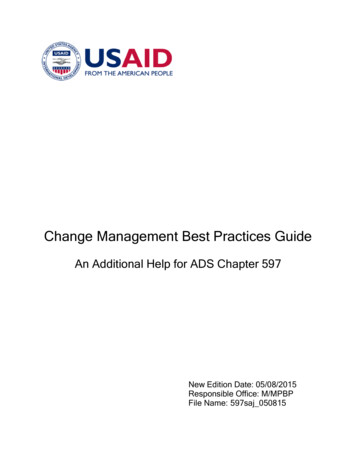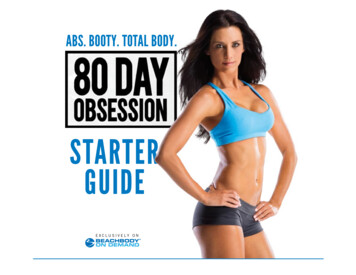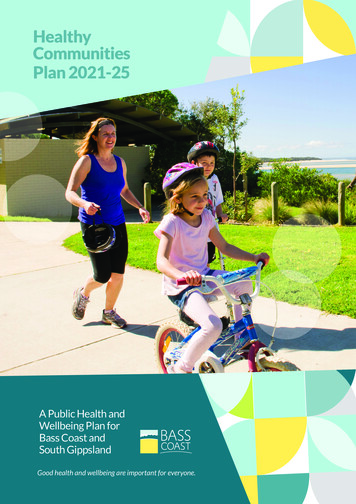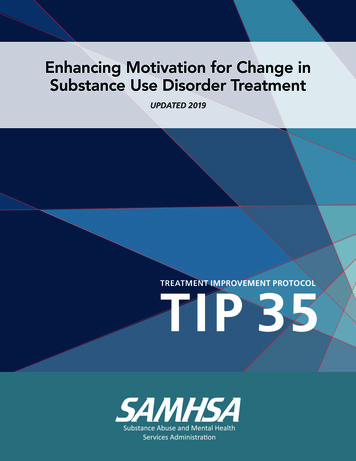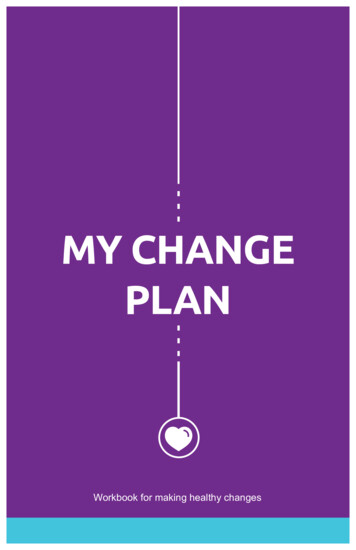
Transcription
MY CHANGEPLANWorkbook for making healthy changes
CONGRATULATIONS!Quitting smoking is an important change in your life. You canquit smoking. For many people, the decision to quit smoking is adifficult one. They also don’t take advantage of resources that canhelp them to quit. You have taken these initial steps.2INTRODUCTIONIn this workbook, we will give you some useful information aboutputting together your own quit plan. This will include thinking aboutaddressing aspects of your environment, changing your behaviourand considering medications. We will also help you consider otherhealthy behaviour changes related to nutrition, exercise, alcoholintake and other factors that contribute to your overall health. It isa good idea to come back to this book repeatedly while you aretrying to quit or stay quit.3
Chapter 1: Setting the StageTable of ContentsChapterPage1. Setting the Stage52. Behaviour Change Roadmap: The 4-Point PlanA roadmap to help you change your smoking behaviour.You can also use this roadmap when making other healthybehaviour changes.93. Nicotine Replacement Therapy (NRT)Just for fun, a quiz to test your knowledge about NRT. Alsogives you important information on the proper use of NRT.214. Medications Other than NRT:Zyban and Champix More choices of medication. Provides information to helpsee if they may be right for you.335. Other Healthy ChangesSome other changes that you may want to consider toimprove your health even more.376. Other Resources and Contact InformationOur contact information. Other telephone numbers andwebsites you can call or visit. Also some books you canread. Scientific references supporting the information inthis book are also here.494Some important things to considerQuitting smoking is a process, not an eventSmoking is an automatic behaviour; you may not always beaware of reaching for a cigaretteOne pack of cigarettes per day equals 110,000 hand to mouthrepetitions per yearSmoking is linked with many behaviours: eating, drinkingalcohol or coffee, waking up, drivingSmoking is also linked with social events: breaks at work,parties, friends’ homesSmoking cessation medications (NRT, Zyban or Champix ) areonly a part of your quit smoking strategy; you also need a plan thatincludes behavioural tactics.5
Good reasons for quittingDecision to ChangeQuitting smoking is one of the most important things you will everdo:You may live longer and have a better quality of lifeChanging my currentbehaviourContinuing the behaviour inthe same wayBenefitsThe people you live with, especially your children, will behealthierQuitting will lower your chance of having a heart attack, strokeor cancerYou will have extra money to spend on things other thancigarettesCostsWhat other reasons do you have for quitting smoking?Reasons for ChangeMaking a commitment to meeting your goal is important to yoursuccess. Sometimes, it’s easy to forget why you’re making thechange, so write down your reasons and use this as a reminder toyourself when things seem tough!Goal StatementThe most important reasons why I want to change are:The behaviour I want/need to change is:1.2.What is your goal now?3.4.5.6Start date:Achievement date:7
Readiness RulerPeople usually have several things they would like to changein their lives – this may be only one of those things. Answer thefollowing three questions with respect to the goal you have set.Q1. How important is it to change this behaviour?Q2. How confident are you that you could make this change?Chapter 2: Behaviour ChangeRoadmap: The 4-Point Plan1Strategize2Take Action3Optimize4Prevent Relapse (Persevere)Q3. How ready are you to make this change?These 4 steps are useful in helping to change any behaviourwhether it’s quitting smoking, improving your nutrition, doing moreexercise, decreasing alcohol use, etc.For reflection: Readiness RulerWhat are 3 reasons you are at and not zero?1.2.3.89
1. StrategizeSmoke-free environmentsMake home and vehicle smoke-freeFind areas of home to restrict smoking behaviour if entirehome cannot be smoke-freeWork environment – avoid smokers and smoking areas atworkSocial events – avoid social events where there will besmoking while you are trying to quitGet rid of all things that remind you of smoking (e.g., ashtrays,lighters, matches.)Other:Support SystemsIdentify all positive support Partner, family, friends, colleagues Professionals – physician, pharmacist, dentist, nurse, etc. Other support – Smokers’ Helpline, groups, websites, selfhelpIdentify all negative influencesGrief Process: Experiencing a lossDenial: “This can’t be happening to me.” Not acceptingor even acknowledging the loss or potential loss.Anger: “Why me?” Feelings of wanting to fight backor get even, anger at yourself, the tobacco industry,people in your life, blaming.Bargaining: Attempting to make deals or to stop orchange the loss. Wishing, praying for cigarettes tocome back.Depression: Overwhelming feelings of hopelessness,frustration, mourning loss of cigarette. Feeling lack ofcontrol, perhaps feeling suicidal.Acceptance: Finding the good that can come out of thepain of loss, finding comfort and healing. Our goals turntoward personal growth.Triggers & Coping SkillsSample PlanTriggersCoping SkillsSmoke with co-workerevery day at breaksTell co-worker“I am quitting”After mealsChew gum after meals,get up from table rightawayStress at work gets toomuch on some daysPlan to take walks whenstress is high Other smokers (partner, family) People who don’t want you to quit smoking Unhelpful “encouragement” to quit1011
Triggers & Coping SkillsChange Plan (Sample Worksheet)TriggersCoping SkillsThe changes I want to make are Changing my morning routine to avoid smoking while I drink a coffeeThe most important reasons why I want to make thesechanges are It will help with cravings, and might save me time in the morning. It would behealthier as well.The steps I plan to take in changing are (1) Wake up 30 minutes earlier; (2) Do some exercise at home or at the gym; (3)Go right to work after I have a shower; (4) Pick up coffee on my way to work.TriggersCoping SkillsThe ways other people can help me are Ask my partner to help the kids get ready for school. Tell the kids I need them tohelp out in the mornings too.TriggersCoping Skills12I will know that my plan is working if I actually get out of bed when the alarm goes off, and I can put off having acoffee.Some things that could interfere with my plan are.My partner makes his own coffee – the smell might be a trigger.13
Change Plan WorksheetThe changes I want to make are Identifying Barriers & Solutions toChangeWhat could get in the way of quitting (barriers), and whatcan you do about it (solutions)?The most important reasons why I want to make thesechanges are Possible Barriers:Proposed Solutions:The steps I plan to take in changing are The ways other people can help me are Enhance your strategyI will know that my plan is working if Some things that could interfere with my plan are.14Keep a diary/log Record details about the behaviour you want to change Simply keeping track can lead to a changeDiary pages are provided at the end of this bookletA variety of medications are available to help you quitsmoking. Have you considered any? Look for moreinformation on pages 21-36.15
2. Take ActionTake Action!Asking for FeedbackSocial supports (family members, friends, colleagues)Professionals (doctor, nurse, pharmacists, others)Avoid triggers or situationsFeedback on my plan?Change the trigger or situationThings missing?Find an alternative or substitute for the cigarette in responseto the trigger or situation3. OptimizeIdentify problemsIdentify any problems you have encountered so far and what arepotential solutions:WATCH FOR SABOTEURS & ENLIST SUPPORTERS!Notes & Important NumbersHave you experienced any changes in mood?Consult your doctorAre you still experiencing withdrawal symptoms?Adjust your medicationsAre you gaining weight?Look at your nutrition and exerciseAre you having overall difficulty?Review your quit plan1617
4. Prevent RelapseDealing with “slips”Nearly 50% of Canadian smokers reported they tried to quit 1or more times in the past yearRelapses or lapses are a part of the process and can becommonWhat happened? it would most likely be in the following situation:Getting together with friends on Saturday nightWhat coping strategies could I use to avoid smoking a cigarette inthis situation?Avoid the triggers or situations Miss this event while I’m trying to quit smokingCan I prevent that situation?Change the trigger or situationWhat can I do when I am in that situation again? Ask friends to smoke outside because I’m quittingWhich options worked and what more do I need to do?Find an alternative or substitute for the cigaretteIf I were to relapse. it would most likely be in the following situation:What coping strategies could I use to avoid smoking acigarette in this situation?18Example: If I were to relapse. When someone lights up, get support from other friends Get up and get glass of water or move to another part ofthe roomRelapse Warning Signs“One cigarette won’t hurt”“I’m sure I can smoke socially now that I’ve quit”“I’m stressed! Just this once to help me get through this”“I’ve been quit for long enough that I have control over this”19
Current Motivation & Next StepsWhere were you when you came here today, and where areyou now?Chapter 3: Nicotine ReplacementTherapy (NRT)QUIZWhat do you need to do to continue to make positivechanges?Testing Your Knowledge: Myths and facts aboutNicotine Replacement Therapy (NRT)TRUE or FALSE:1. Nicotine is the harmful ingredient in cigarettesNicotine in cigarettesCarbon monoxide and carcinogens cause harm, not nicotineWhat is your next step?There are 60 cancer-causing chemicals in cigarette smoke;nicotine is not one of themNicotine is the addictive component in cigarette smokeTRUE or FALSE:2. Nicotine Replacement Therapy (NRT) is a safe andclean delivery system of nicotineNicotine Replacement Therapy (NRT)Provides the body with nicotine to help minimize withdrawalsymptoms and cravingsDoes not contain the toxins one gets from cigarettesShown to almost double quit ratesMost effective when combined with counseling or a supportgroupNRT is safer than smokingNRT gum used for up to 5 years was not associated withincreased hospitalization due to cardiovascular disease2021
TRUE or FALSE:3. 21mg of nicotine is the strongest level of patch that asmoker can wearHigher than 21mg21mg or STEP 1 patch is the highest dose available forpurchase, but you may use additional patches or combinewith other types of NRT (for example, 21mg patch and2mg gum)Champix (varenicline) is another smokingcessation medication. Champix is not usedtogether with NRT.Consult with your doctor or pharmacist firstTRUE or FALSE:4. Smoking while on the patch increases the risk of aheart attackPatch and heart attackPeople tend to blame NRT for heart attacks. However,the heart attack was most likely caused by somethingelse, such as years of smoking, poor diet and unhealthylifestyleAnswers:1. False2. True3. False4. False5. FalseTRUE or FALSE:5. NRT should not be used at the same time or incombination with Zyban (bupropion)(Zyban is another smoking cessation medication)NRT and ZybanNRT and Zyban work differentlyThey can be used together or aloneZyban is available by prescription onlyConsult with your doctor2223
About Nicotine Replacement Therapy(NRT)NRT is a group of smoking cessation aids that provide cleannicotine in either long-acting (i.e., patch) or short-acting(e.g., gum, inhaler, lozenge and mouth spray) formsWorks by replacing a portion of the nicotine in your cigarettesso that your withdrawal symptoms are minimizedWith less severe withdrawal symptoms you face an easiertime quitting smokingPossible Tobacco Withdrawal weatingAppetitechangesWhy use Nicotine ReplacementTherapy (NRT)?1. Doubles your chances of successfully quitting2. Safer to use than tobacco – no long-term negative healtheffects have been found for NRT3. Works well in combination with other strategies (such aschanging what you do, how you think about smoking, and how youfeel about smoking and quitting)Who should NOT use NicotineReplacement Therapy (NRT)?If you are currently taking the medication Champix (alsocalled Chantix or varenicline)If you recently experienced any of the following please consultwith your doctor before starting NRT:StrokeHeart attackWorsening angina or arrhythmia25
Types of NRT on the marketYou can use these general guidelines to choose the right type ofNRT for you:If you smoke.Less thanNicotine Patch(24-hour)21, 14 & 7 mg dosesNicotine Patch(16-hour)15, 10 & 5 mg dosesNicotine Inhaler10 mg dose10 cigarettesdaily:Start withPATCH (14 or 7mg) orINHALER orGUM (2mg) orLOZENGE (2mg) orMOUTH SPRAY then reduce use over severalweeksNicotine Gum4 & 2 mg dosesNicotine Lozenge4, 2 & 1 mg dosesNicotine MouthSpray1mg / sprayBetween10 - 20 cigarettesdaily:then taper down over severalweeksThese are available over-the-counterOther smoking cessation aids:Zyban Champix (bupropion)(varenicline)You need a prescription for theseHow to choose which NRT to use?Important considerations:PATCH (21mg) orINHALER orGUM (2mg) orLOZENGE (2mg) orMOUTH SPRAY More than20 cigarettesdaily:PATCH (21mg) orINHALER orGUM (4mg) orLOZENGE (4mg) orMOUTH SPRAY then taper down over severalweeksDid you use NRT in the past?Was it the patch, inhaler, gum, lozenge, mouth spray, or a combination?How was your experience using NRT?26You may need to use a higher dose or combination therapy.Talk to your doctor, nurse or pharmacist about a more tailoredtreatment plan.27
Nicotine Patch Delivers a continuous dose of nicotine throughout the day May cause sleep disturbance or nightmares Take off the patch before bed if this occursPossible side effects: May cause skin irritation Reaction to the adhesive Nicotine can be an irritant but this is not an allergy Talk to your pharmacist about medicated creams thatmay help (aloe, hydrocortisone)How to Use the Nicotine Patch1. Set doses: guides you from Step 1 to Step 2 to Step 32. Apply to clean, dry area; apply on a different part of arm (orupper body) each day3. Remove old patch before applying new one4. Touch only small corner of adhesive (sticky back of the patch)5. Rub patch after application – make sure all edges are stuck6. Wash hands in water after application – don’t use soap7. Fold in half (sticky parts together) and discard old patch out ofreach of children and animals – can still be harmfulUseful tips:Nicotine InhalerSmall, tube-shaped mouthpiece Delivers nicotine through “puffing” Absorbed in the mouth, throat and upper respiratory tractPossible side effects: Throat & mouth irritation, headache, nausea,indigestionHow to Use the Nicotine Inhaler Use about 6 cartridges per day Reuse cartridge multiple times: a single cartridge lasts forapproximately 80-400 puffs or 20 minutes of continuouspuffing Puff like a cigar, not deeply into the lungs Flexible – use as much or as little as needed Use more frequently at first, and at times when you most cravecigarettes May notice a burning, warm or cool sensation when inhaling –this is OK unless it becomes bothersome Clean inhaler on a regular basis with soap and water You may be ready to stop using the inhaler after you are downto 1 to 2 cartridges per day Do not use lotion or moisturizing soap where you intend toapply the patch – patch will not stick well If patch doesn’t stick well: May need to clean area with alcohol wipe Use medical tape to hold patch in place2829
Nicotine Gum & Lozenge Come in different flavours: mint, fruit, cinnamon Delivers nicotine via the lining of the mouthPossible side effects: Upset stomach, nausea/vomiting,dizziness, mouth/throat irritation, hiccupsHow to Use the Nicotine Gum Flexible – use as much or as little as needed “Chew, Chew, Park” – bite on the gum once or twice, then parkbetween your cheek and gums; repeat every minute or so Start with 1 piece every hour or so, then gradually decreaseover several weeks You may be ready to stop using the gum after you are down to1 to 2 pieces per dayHow to Use the Nicotine Lozenge Not like ordinary lozenges or candy. Do not chew or swallow;simply place the lozenge in your mouth and allow it to dissolveslowly Start with 1 lozenge every 1 to 2 hours for the first few weeks(about 8 lozenges a day) Then gradually decrease: 1 lozenge every 2 to 4 hours, then 1lozenge every 4 to 8 hours You may be ready to stop using the lozenge once you aredown to 1 to 2 pieces per day You may feel a hot, peppery or tingling sensation in the mouth– this is expectedUseful tip: While the lozenge is in your mouth do not drink coffee, tea,soft drinks, alcohol or orange juice – it will interfere with thelozenge’s effectivenessUseful tips: Don’t rush: chew slowly to minimize some side effects Carry nicotine gum with you all the time for several monthsafter your treatment (often just one cigarette is enough to startsmoking again)Nicotine Mouth Spray Small, portable dispenser Delivers nicotine through a fine mist that is sprayed directlyinto the mouth Nicotine is quickly absorbed in the mouthPossible side effects: Tingling lips, hiccups3031
How to Use the Nicotine Mouth Spray Use one spray when you have a craving to smoke. If cravingdoes not disappear in a few minutes, use a second spray.Chapter 4: Medications Otherthan NRT: Zyban and Champix Maximum dose is 2 sprays at a time, 4 sprays per hour, 64sprays per day. The first time using the spray, point spray nozzle away andpress down on dispenser a few times until a fine mist appears.This process may need to be repeated if spray has not beenused in 2 or more days. Point spray nozzle into open mouth, holding it as close aspossibleDid you know Zyban for smokingcessation was discovered accidentally?The anti-smoking effect of Zyban wasfirst noticed in U.S. veterans takingthe anti-depressant formulation of this drug. Press the top of dispenser to release one spray into openmouth Do not inhale while spraying to prevent the spray from gettingdown your throatUseful tips: Avoid letting the spray touch your lips – if it does you mayexperience a tingling or burning sensation on your lips Avoid swallowing for a few seconds after spraying to reducethe chance of hiccups You may notice a strong taste – this is the taste of nicotine andis normal NOTE: mouth spray contains trace amounts of alcoholAbout Zyban Like NRT, Zyban is a first-line medication for smokingcessation. It comes in tablet form. Unlike NRT, it is only available by prescription from yourphysician or pharmacist Unlike NRT, it does not contain nicotine. The medicinalingredient in Zyban is bupropion. Like NRT, Zyban can minimize your experience of withdrawalsymptoms, which can make quitting easier for you Dosage form: 150mg tablets Most common side effects: dry mouth, insomnia3233
Why use Zyban ?1. Can double your chances of quitting smoking2. Convenient: you take the tablets only once or twice a day3. Can be combined with counseling support or NRT to improvesuccess rate in some casesUseful tip: To maintain effectiveness, try not to skip doses. But if youforget a dose, do not take two tablets next time.About Champix Who should NOT use Zyban ?If you are currently taking WellbutrinIf you have a current seizure disorderDid you know Champix iscalled Chantix in theUnited States?If you have a history of eating disordersImportant!Before starting Zyban, discuss with your doctor if you havedepression or other mental health diagnoses.Also, discuss with your doctor your full list of medicationsas Zyban can interact with other drugs and they may needdose adjustment.How to Use Zyban ? Set a quit date that is about 1 week after starting themedication Follow the instructions from your doctor and pharmacist Typically Zyban is used as follows: Day 1 – 3: take one 150mg tablet once daily Like NRT and Zyban, Champix is a first-line medication forsmoking cessation. It comes in tablet form. Like Zyban, it is only available by prescription from yourphysician or pharmacist Unlike NRT, it does not contain nicotine. The medicinalingredient in Champix is called varenicline. Champix reduces cravings for cigarettes so quitting is madeeasier Champix also decreases the pleasurable effects of smoking soyou are not as tempted to light up Dosage form: 0.5mg & 1mg tablets Most common side effects: nausea/vomiting, abnormaldreams, GI disturbance Day 4 – end of treatment: one 150mg tablet twice daily, atleast 8 hours apart Swallow the tablets whole – do not chew, cut, crush ordissolve tablets before taking (as this will destroy the tablet’ssustained release mechanism and can lead to increased side effects)3435
Why use Champix ?1. Increases your chances of quitting smoking; as good as eitherNRT or Zyban, or betterChapter 5: Other Healthy ChangesTarget: Improving your health2. Convenient: you take the tablets only once or twice a day3. Champix does not interact with too many other drugs, whichmakes it more suitable for some people who are on othermedicationsQuitting smoking improves your health. But there are other riskfactors for disease that you can reduce to improve your healtheven further. You can apply the strategies in this book to help youmake changes in all these areas.Who should not Use Champix ?Sounds too difficult?Well, it may not be very easyIt is not recommended that you use both Champix and NRT atthe same time since Champix (varenicline) works by blockingthe effects of nicotine.but it might not beas hard as you think.So, give it a try!Important!Before starting Champix, tell your doctor if you havedepression or other mental health diagnoses.How to Use Champix ? Set a quit date that is in week 2 of starting Champix (it takes afew days to reach effective level of medication in your body) Follow the instructions from your doctor and pharmacist A typical dosing regimen is as follows: Day 1 - 3: take one 0.5mg tablet once daily Day 4 - 7: one 0.5mg tablet twice daily, several hoursapart Day 8 - end of treatment: one 1mg tablet twice daily,several hours apartUseful tip:Medication (Champix , Zyban or NRT) works well when you aremotivated to quit smoking36Risk FactorsSmokingExcessivealcohol drinkingPoor nutritionPhysicalinactivityPoor stressmanagementExamples ofChronic DiseasesCancerCardiovasculardiseaseDiabetesMental IllnessPoor sleepIt makes sense to try and modify several risk factors at the sametime. This is because they often occur in clusters.37
The Health Promotion 6-PackTobacco UseNutritionSleepChoose Healthy OptionsStress TolerancePhysical ActivityAlcohol Whole grains Low-fat dairyReduce Salt Intake Most of the sodium in our diet is from processed food (e.g.,canned food, cookies, microwave/frozen food) Most Canadians consume more sodium than recommended –reduce sodium intake to 1500 mg/dayFor more nutrition tips, visit www.eatrightontario.caRefer to pages 9 - 36SleepNutrition and salt intakeFast Facts60% of men and 45% of women in Canada are overweight orobese59% of adults in Canada eat less than 5 servings of fruits andvegetables daily, far less than the recommended 7-10 servings Lack of sleep and weight gain are related. If you get less thansix hours of sleep each night, you are at increased risk forobesity. Lack of sleep is associated with long-term healthconsequences, including chronic medical conditions likediabetes, high blood pressure, and heart disease.Tips for Improved SleepPortion Size Matters A well-balanced plate consists of ½vegetables, ¼ protein (e.g., beans,meat, poultry or fish), and ¼ grainsand starches (e.g., rice, pasta).www.diabetes.ca Lean proteins Reducing sodium (& salt) in our diet reduces blood pressureand hypertension-related complicationsTobacco Use Use an 8" dinner plate instead of astandard 10" plate Different colouredvegetables1/2Vegetables1/4Protein1/4Starch Dark shades Cool the bedroom (AC or fan) Eye mask and/or ear plugs Keep consistent sleep schedule Skip sedatives Minimize caffeine late in the day Turn off electronics (tv, phones, computers) before bed3839
Alcohol MisusePhysical ActivityAlcohol misuse includes risky/hazardous and harmful drinkingthat places individuals at risk for negative health outcomes.Reduce alcohol consumption to low-risk drinking guidelines:0 drinks for high-risk special populations (e.g., pregnantwomen)2 standard drinks maximum daily for women3 standard drinks maximum daily for men10 standard drinks maximum weekly for womenIf you currently do notexercise regularly, startslowly & build upAdd up your activitiesin periods of at least 10minutesDo muscle- andbone- strengtheningactivities 2 or more days aweekGet 2.5 hours of moderateto vigorous exercise perweekCheck with your physician before you start a new exerciseprogram.15 standard drinks maximum weekly for menIt’s easier than you think!A Standard Drink is: Walk whenever you can – get off the bus early, use the stairs Reduce inactivity for long periods, like watching TV Get up from the couch - stretch, bend for a few minutes everyhourWineBeerSpirits142 mL(5 oz.)341 mL(12 oz.)43 mL(1.5 oz.)12% alc/vol5% alc/vol40% alc/vol Play with your kids, choose to walk or cycle for short trips Start with a 10 minute walk – gradually increase the time.Useful website: www.participaction.comFor many smokers alcohol, is a trigger to smoke, and viceversa. It can be helpful to stop drinking when you are quittingsmoking.4041
Stress ToleranceImportant to know: Unmanaged stress can lead to highblood pressure, arterial damage, irregular heart rhythms and aweakened immune system.Many people often deal with their stress by resorting to unhealthybehaviours such as smoking.Some healthier alternatives to help manage stress: Eat healthy, exercise regularlyAdopt proper sleeping habitsDeep breathing, meditation, yogaTake time for yourself - do something you enjoyPrioritize and delegate tasks; be realistic with expectationsSeek counseling supportUnmanaged chronic stress can increase the risk of developingdepression.Depression is much more than simple unhappiness.Symptoms include: Sad, despairing mood that’s present most days and lasts mostof the day Loss of interest in work, hobbies, people, sex Change in appetite, weight Sleep problems Feeling useless, hopeless Agitation, irritability, fatigue There are other symptomsMany people with depression smoke and many smokers havedepression. Depression can increase the risk of a heart attack.Daily DiaryKeeping a diary is a key part of any behaviour change program.It gives you accurate details about the behaviour you want tochange, and can also help you to identify high risk situations. Thisdiary can also help you to see when you aren’t likely to engagein this behaviour, and to identify what was different about thosedays. Keeping a diary takes time and commitment, but researchhas shown that simply keeping track of a behaviour can lead tochange!What is your goal for this week?Did you smoke?If yes, how manycigarettes?Describe thesituation (e.g.,were you alone orin a social settingetc.)Thoughts andfeelings (Whatwere you thinkingand feeling in ySaturdayTreatmentMedications, psychoeducation, and psychotherapy, self-helporganizations, online resources (www.depressioncenter.net)42Sunday43
Daily DiaryDaily DiaryWhat is your goal for this week?What is your goal for this week?Did you smoke?If yes, how manycigarettes?Describe thesituation (e.g.,were you alone orin a social settingetc.)Thoughts andfeelings (Whatwere you thinkingand feeling in thissituation?)Did you smoke?If yes, how daySundaySunday44Describe thesituation (e.g.,were you alone orin a social settingetc.)Thoughts andfeelings (Whatwere you thinkingand feeling in thissituation?)45
Daily DiaryDaily DiaryWhat is your goal for this week?What is your goal for this week?Did you smoke?If yes, how manycigarettes?Describe thesituation (e.g.,were you alone orin a social settingetc.)Thoughts andfeelings (Whatwere you thinkingand feeling in thissituation?)Did you smoke?If yes, how daySundaySunday46Describe thesituation (e.g.,were you alone orin a social settingetc.)Thoughts andfeelings (Whatwere you thinkingand feeling in thissituation?)47
Chapter 6: Other Resources andDaily DiaryContact InformationWhat is your goal for this week?Did you smoke?If yes, how manycigarettes?MondayDescribe thesituation (e.g.,were you alone orin a social settingetc.)Thoughts andfeelings (Whatwere you thinkingand feeling in thissituation?)Coping ective(feeling)Avoid people or placesthat trigger problematiccoping strategies (e.g.,drinking, drug use, selfharm)Remember the positive& negative things aboutusing healthy copingstrategies.Read inspiring literatureon self growth orrecovery.TuesdayIdentify and avoid highrisk situations.Tell yourself thatfeelings, even difficultfeelings, are normal.WednesdayTake a “buddy” whengoing to a risky place /situation.Distract yourselfby thinking aboutsomething else.ThursdayFridaySaturdaySunday48Leave risky situations, or Recognize whenlimit how long you stay. you are making selfdefeating statements orPhone someone forrationalizations (e.g., Isupport.am such a loser).Go for a walk.Plan ahead for any riskyExercise or dosomething physical.situations or “loopholes”to your plan.Stand tall and feel yourbody’s strength. Remindyourself that you are astrong adult.Imagine a
Smoking is linked with many behaviours: eating, drinking alcohol or coffee, waking up, driving Smoking is also linked with social events: breaks at work, parties, friends’ homes Smoking cessation medications (NRT, Zyban or Champix ) are only a part of your quit smoking strategy


